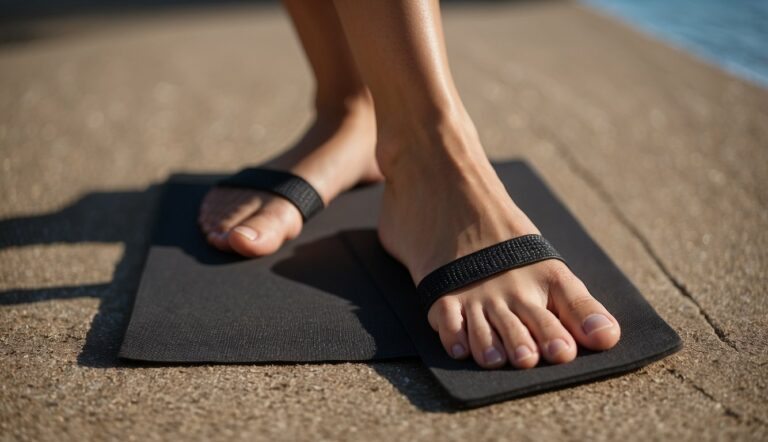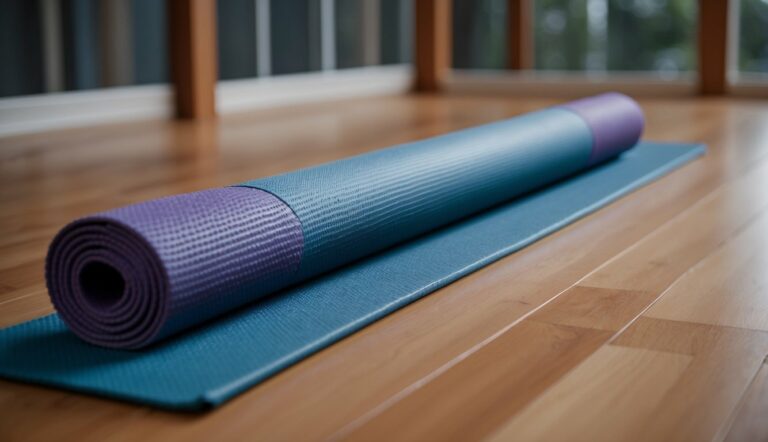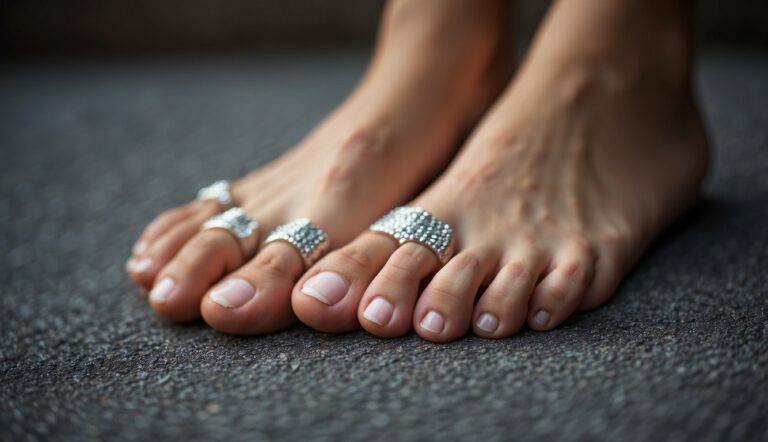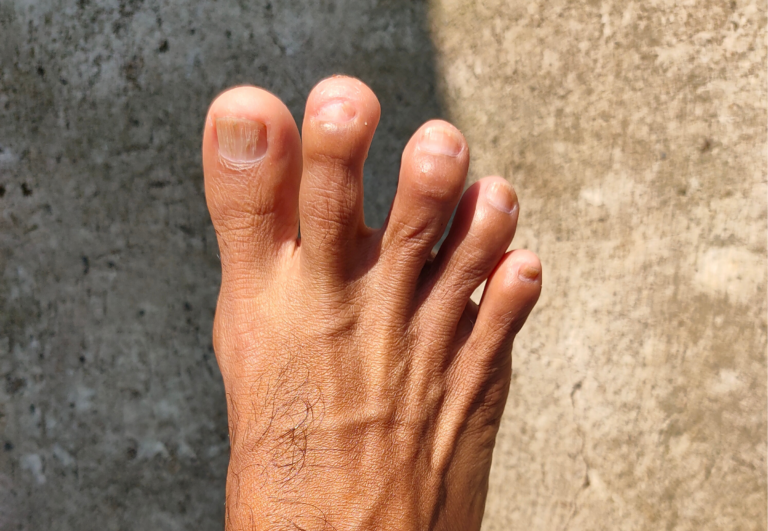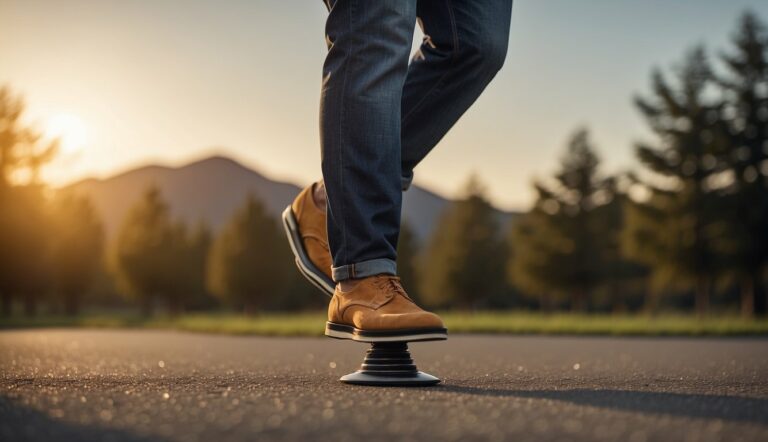Toe Spacer Workout: Enhancing Foot Strength and Flexibility
As a seasoned user of toe spacers, I’ve come to appreciate their value in a well-rounded fitness regimen. Toe spacers, also known as toe separators, are simple devices designed to realign and maintain proper toe spacing. Their primary goal is to counteract the compressive forces exerted on our feet by tight footwear and the demands of daily life.
Integrating toe spacers into a workout routine can significantly enhance foot health, strength, and flexibility. Wearing these during specific exercises can aid in improving toe alignment, alleviating discomfort, and possibly preventing future foot issues. For those seeking a practical way to support and fortify their foot structure, toe spacers might just be the missing piece in their fitness puzzle.
Most Helpful Toe Spacer Workout
A toe spacer workout typically involves exercises that are designed to be performed while wearing toe spacers, which help to separate and align the toes. This can lead to improved foot mechanics, balance, and strength.
Here’s a toe spacer workout that focuses on these aspects:
- Toe Splay:
- Sit or stand with toe spacers in place.
- Actively spread your toes apart and hold for a few seconds, then relax.
- Repeat for 10-15 repetitions to encourage toe separation and flexibility.
- Toe Curls:
- Sit with your feet flat on the ground and a towel placed under your toes.
- Curl your toes to scrunch the towel towards you, then release.
- Perform 2-3 sets of 10-15 repetitions to strengthen the muscles under your feet.
- Toe Press Downs:
- Stand or sit with toe spacers in place.
- Press each toe down into the ground, trying to isolate the movement to one toe at a time.
- Hold each press for a few seconds, then release.
- Do 10 repetitions for each toe to enhance individual toe strength.
- Marble Pickups:
- Place a bowl and several marbles on the floor.
- While seated, use your toes to pick up the marbles and drop them into the bowl.
- Continue for 1-2 minutes to improve toe dexterity and strength.
- Heel Raises:
- Stand with toe spacers in and feet hip-width apart.
- Slowly raise your heels, shifting your weight onto the balls of your feet and toes.
- Lower back down with control.
- Perform 2-3 sets of 10-15 repetitions to engage the calves and arches.
- Balancing Exercises:
- Stand on one foot with toe spacers in to challenge your balance.
- Try to maintain the position for 30-60 seconds, then switch feet.
- This exercise engages the muscles in the feet and toes that are responsible for stability.
- Walking:
- Simply walking around with toe spacers can be a good exercise, as it allows your toes to maintain proper alignment under the dynamic conditions of movement.
- Yoga Poses:
- Practice yoga poses such as Mountain Pose (Tadasana), Tree Pose (Vrksasana), or Warrior II (Virabhadrasana II) with toe spacers to promote balance and foot alignment.
- Sand Walking:
- If you have access to a beach or a sandbox, walking in sand with toe spacers can provide a natural resistance workout for your toes and the entire foot.
- Cool Down and Stretch:
- Finish your workout with some gentle stretches for your toes, feet, and calves to maintain flexibility and reduce any tightness.
This toe spacer workout can be performed 2-3 times per week as part of your regular fitness routine. Always listen to your body, and if you experience any pain or discomfort, stop the exercises and consult with a healthcare professional. It’s also important to ensure that the toe spacers fit well and are comfortable for the duration of the workout.
Toe Spacer Overview
Toe spacers are devices designed to improve foot health by realigning the toes to their natural position. Let’s explore the variety of toe spacers available, their anatomical benefits, and the foot conditions they aim to address.

Types and Materials
Silicone Toe Spacers: Most commonly, toe spacers are crafted from silicone. This material is favored for its flexibility and comfort. Correct Toes and Earth Runners Mobility Toe Spacers are popular silicone-based options that offer durability and ease of use.
Gel and Rubber Varieties: Alternative materials include gel, which is similar to silicone, offering a soft, malleable quality. Rubber toe spacers, while less common, provide a firmer support and can be a viable option for those needing a more robust toe separation.
Table 1: Common Materials Used in Toe Spacers
| Material | Features | Brands |
|---|---|---|
| Silicone | Flexible, comfortable | Correct Toes, Earth Runners |
| Gel | Soft, malleable | Various generic brands |
| Rubber | Firm support | Less common, varied brands |
Anatomical Benefits
Toe spacers work to separate the toes gently, promoting a more natural toe alignment which can enhance balance and foot mechanics during movement.
Strengthening: By spreading the toes, toe spacers can strengthen the intrinsic muscles of the foot, important for overall foot health.
Alignment: Consistent use can improve toe alignment, influencing better posture and walking patterns.
Common Foot Conditions Addressed
Plantar Fasciitis: While not a cure, toe spacers can serve as a preventative tool against plantar fasciitis by reducing discomfort and contributing to a better foot posture.
Bunions: Regular use may assist in the management of bunion discomfort. However, it’s crucial to consult a medical professional for a comprehensive treatment plan.
List 1: Foot Conditions Targeted by Toe Spacers
- Plantar Fasciitis
- Bunions
- Hammertoes
- Crossed Toes
In summary, from their materials to their design, toe spacers are specialized tools for better foot health that offer support for various foot conditions. Use them wisely as part of a wider foot care regimen for improved comfort and foot function.
Toe Spacer Workouts and Exercises
Incorporating toe spacers into workouts can significantly enhance foot strength and mobility. They promote a natural toe spread which is essential for balance and stability.
Strengthening Routines
Toe spacers are beneficial for adding extra intensity to foot muscle strengthening routines. I recommend exercises such as toe raises and curls to specifically target the intrinsic foot muscles. For example:
- Toe Raises: Place toe spacers between each toe and steadily lift your toes upwards, hold for a few seconds, and release.
- Toe Curls: With toe spacers inserted, attempt to curl your toes downward as if gripping something with them.
Stretching and Flexibility
The role of toe spacers in improving flexibility and stretching is often underrated. They assist in better range of motion and promote blood flow to the feet. A simple stretching routine includes:
- Big Toe Stretches: While sitting, place a toe spacer and gently pull the big toe away from the rest, holding the stretch for a few moments.
- Toes Spread and Reach: With spacers in place, spread your toes as wide as possible, then reach them forward and hold to stretch the top of the foot.
Balance and Stability Training
Toe spacers play a crucial role in balance and stability exercises by aligning the toes in their natural position, increasing the base of support. Common practices include:
- Balance Holds: Stand on one foot with toe spacers in place to challenge your balance and activate stabilizing foot muscles.
- Yoga Poses: During yoga, toe spacers can improve stability in standing poses, such as Tree Pose or Warrior III, aiding in overall performance.
Best Practices for Toe Spacer Usage
Incorporating toe spacers into your routine can greatly benefit foot health and athletic performance. Ensuring proper fit, gradually increasing wear time, and keeping them clean are essential for reaping these benefits.
Fitting and Wear Time
When selecting toe spacers, comfort is paramount. Ensure that they fit snugly but do not cause any pain or discomfort. It’s crucial to start with short periods of wear, typically 15-20 minutes, and gradually increase the duration over time to allow your feet to adapt. For athletes and runners, it’s beneficial to wear spacers during pre-activity stretching and to consider barefoot shoes with a wide toe box for adequate space.
- First-time use: 15-20 minutes
- Incremental increase: Add 5-10 minutes per session
- Maximum wear time: Up to 60 minutes for active use or as tolerated when at rest
Integration into Lifestyle and Activities
Integrating toe spacers into your lifestyle should be a personalized process. For those who practice yoga, inserting toe spacers before a session can enhance balance and alignment. Runners may find toe spacers beneficial during cooldown stretches. When it comes to footwear, opting for designs with a wide toe box ensures that toe spacers can be worn comfortably and effectively.
- Yoga: Wear before or during practice for improved toe alignment
- Running: Utilize during post-run stretching
- Footwear: Choose shoes with a wide toe box for ample space
Maintenance and Care
Toe spacers are generally easy to clean, which is essential for maintaining good hygiene. Most toe spacers can be washed with soap and warm water and should be air-dried before the next use. Inspecting them regularly for signs of wear and tear is also advisable to ensure they continue to provide the intended benefits.
- Cleaning method: Soap and warm water
- Drying method: Air-dry completely
- Inspection: Check for damage periodically
Health and Recovery Applications
Incorporating toe spacers as part of a recovery or preventative regimen can be beneficial for addressing several foot conditions. My experience has shown that these simple tools are valuable for promoting foot health and aiding in the recovery from various ailments. Here’s how they can be used in post-injury contexts and for the prevention of further issues.
Post-Injury and Rehabilitation
After an injury such as hammertoe, hallux valgus (commonly known as bunions), or metatarsalgia, toe spacers can play a critical role in the recovery process. These devices help in maintaining proper toe alignment, which is essential for the even distribution of weight across the foot.
This correct alignment supports the healing of the ligaments and intrinsic muscles. For instance, after a bunion correction, toe spacers can aid in keeping the big toe from drifting back into a misaligned position.
- Hammertoe: Can provide relief by allowing the toes to stretch and preventing further cramping.
- Bunions: Helps to realign the big toe and might reduce the pressure and pain associated.
- Plantar Fasciitis: By aligning the toes, spacers help distribute pressure more evenly, alleviating strain on the plantar fascia.
Prevention of Further Ailments
Aside from recovery, toe spacers are useful in the prevention of foot conditions that can result from improper alignment. They help ensure proper foot mechanics, which can prevent the formation of corns, blisters, and calluses. Regular use of toe spacers can also reduce the risk of foot pain associated with conditions like flat feet and contribute to overall foot health.
- Corns and Blisters: Can be prevented by reducing friction between toes.
- Foot Pain: Alleviates by promoting correct foot alignment and improving balance.
Note: While I share my knowledge and personal experience with toe spacers, it is always best to consult a podiatrist for personalized advice tailored to your specific condition.
Advanced Considerations for Athletes
When integrating toe spacers into your regimen, the key focus should be on enhancing athletic performance and understanding the role they play in foot biomechanics and gait.
Performance Enhancement
In my experience, athletes, especially runners, often seek ways to improve their performance. One actionable step I’ve found is incorporating toe spacers into daily training. These simple devices can significantly impact balance, mobility, and stability—all vital for optimal performance.
- Balance: Toe spacers help maintain the foot in its natural position, which can lead to improved balance during activities.
- Mobility and Stability: Enhanced toe splay contributes to greater foot mobility and stability, aiding in running and other athletic movements.
Efficient foot function is crucial for athletes to perform at their best. Toe spacers assist in distributing pressure evenly across the foot, which can also lead to improved running efficiency.
Biomechanics and Gait
As an avid advocate for foot health, I’ve noticed that proper biomechanics and gait are foundational for athletic success. Utilizing toe spacers helps ensure that feet align naturally with each step.
- Gait Improvement: An aligned gait reduces the risk of overuse injuries and contributes to more efficient movement patterns.
- Pressure Distribution: With the toes spaced out, athletes may experience a more natural and even distribution of pressure during movement.
By encouraging foot function closer to its natural state, athletes can potentially see a reduction in foot-related stress and an increase in performance metrics. It’s important to remember that while I share this advice based on my experience, I am not a medical professional, and this should not substitute for professional medical advice.
Navigating the Toe Spacer Market
When searching for toe spacers, it’s essential to consider the material and cost to find a product that suits your needs without breaking the bank.
Product Analysis
I always recommend examining the material of toe spacers closely, as it directly affects durability and comfort. Toe spacers come in various materials, such as silicon, silicone, foam, gel, and rubber. Silicone options, such as the popular Correct Toes toe spacers, offer flexibility and are often recommended for their hypoallergenic properties. For those practicing barefoot training or using wide toe box shoes, a softer gel might be preferable for its pliability.
Although products like night splints and insoles can also assist with toe alignment, they typically serve different purposes. Night splints are more rigid and aimed at overnight use, while insoles can provide arch support throughout the day but may not offer the same degree of toe separation.
Cost-Benefit Considerations
I find that the cost of toe spacers can vary widely. Cheaper foam or rubber alternatives may not maintain their shape as well as higher-end silicone models, leading to extra spending over time due to replacements. Moreover, while a high price tag might imply quality, this isn’t always the case. It’s crucial to ensure that the benefits align with the price, particularly if the toe spacers will be used in conjunction with narrow toe boxes or high heels, which can require a more durable product to counteract these restrictive shoe types.
Let’s consider the following comparison chart:
| Material | Durability | Flexibility | Cost | Ideal Use Case |
|---|---|---|---|---|
| Silicon | High | Moderate | $$ | Daily Wear, Wide Toe Boxes |
| Silicone | High | High | $$$ | Barefoot Training, Corrective Use |
| Foam | Low | High | $ | Temporary Use, Light Exercises |
| Gel | Moderate | High | $$ | Regular Workouts, Comfort |
| Rubber | Moderate | Low | $ | Infrequent Use |
Through careful analysis of both product attributes and cost considerations, you can select a toe spacer that offers a balance between price and effectiveness for your specific needs.
